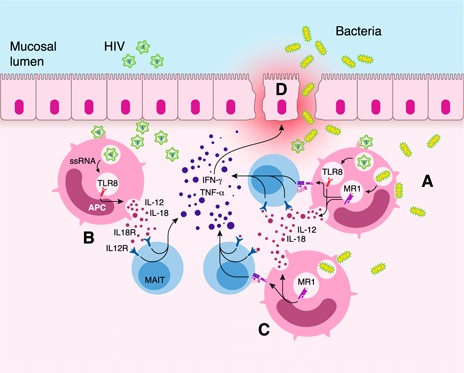Figure 2.

Proposed mechanism illustrating the crosstalk of APCs with MAIT cells across mucosal tissues in HIV infection. (A) Microbial translocation into the gut mucosa could release bacterial‐derived vitamin B metabolites that can activate MAIT cells in an MR1‐dependent manner. (B) APCs could also be exposed to HIV, which in turn can activate MAIT cells in an MR1‐independent fashion. (C) MAIT cells can also be activated through both MR1‐dependent and ‐independent pathways in which APCs are exposed not only to HIV but also to gut bacteria. (Bacteria can also activate the MR1‐independent pathway via stimulation of IL‐12 and IL‐18 secretion, and the type of TLR associated depends on the APC involved.) (D) Aberrant inflammatory responses can affect the mucosal epithelial integrity. Given that MAIT cells are known to produce IFN‐γ and TNF‐α along the mucosa by MR1‐dependent (A and B) and MR1‐independent (C) pathways of MAIT cell activation, IFN‐γ has been reported to induce cellular internalization of proteins associated with tight junctions, resulting in decreased transepithelial resistance in the gut epithelium [60, 61]. Furthermore, TNF‐α has also been reported to induce mucosal epithelial cell death resulting from tight‐junction changes [60, 61], leading to inflammation and mucosal damage (D).
